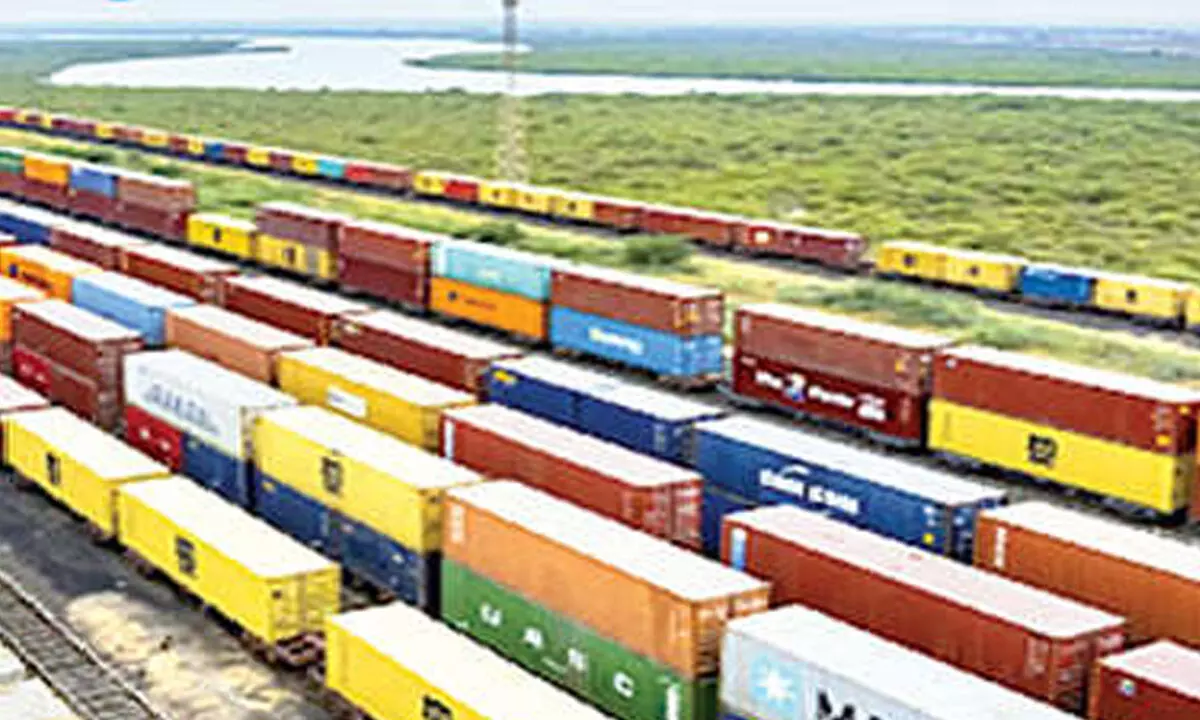Live
- Hrithik Roshan reflects on legacy and inspiration
- Dhivyabharathi promises an unforgettable experience with ‘Kingston’
- India remains a bright spot in global GDP growth trajectory: Economists
- Director Kiruthiga Udhayanidhi encourages actors to embrace bold roles
- ‘Fateh’ review: Feast to action lovers
- Samantha overcomes health setbacks; shares updates on social media
- Kejriwal swindled Rs 2,026 cr through liquor scam, shows CAG report
- Angola reports 119 cholera cases, including 12 deaths
- Splash Colors Media, Alinea Avighna Studios, and Settle King Begin Shooting for Production No. 1
- South Korea: Black boxes of crashed Jeju Air plane missing final four minutes of data
Just In

DFCCIL was incorporated as Schedule ‘A’ company under the Company’s Act 1956 on Oct 30, 2006
To improve manufacturing capabilities and enhance global competitiveness, any developing economy must prioritize improving its logistics infrastructure. Having a well-connected set-up facilitates a seamless supply chain ecosystem. Dedicated Freight Corridors (DFCs) in India are doing precisely this.
With the Union Government aiming to reduce logistics cost to eight per cent of the GDP from the current 13–15 per cent, these rail networks are strategically established to make movement of goods faster, cost-effective and efficient. In a recent development, the Indian Railways is also looking to establish 100 more cargo terminals, which will further strengthen DFCs. Broad-gauge freight corridors are under construction. They are high-capacity railway corridors exclusively meant for transportation of goods and commodities.
India announced the creation of dedicated freight corridors in Parliament while presenting the Railway Budget for 2005-06. In April 2005, the DFC project was discussed at the Japan-India Summit Meeting. It was included in the declaration of co-operation signed between the Prime Ministers of India and Japan for a feasibility study and possible funding of the dedicated rail freight corridors by the Japanese government. The feasibility study report was submitted to India’s Ministry of Railways in October 2007. A special purpose vehicle for the construction, operation, and maintenance of the DFCs led to the establishment of Dedicated Freight Corridor Corporation of India Limited (DFCCIL) to undertake planning and development, mobilisation of financial resources, construction, operation and maintenance, and business development of the DFCs. DFCCIL was incorporated as Schedule ‘A’ company under the Company’s Act 1956 on October 30, 2006. In a recent study, conducted by the University of New South Wales (UNSW), India’s Dedicated Freight Corridors (DFCs) were projected to boost the country’s GDP by Rs. 16,000 crore. The findings, shared by DFCCIL, highlight the transformative economic impact of the corridors, particularly the Western Dedicated Freight Corridor (WDFC). The operationalization of the WDFC has significantly reduced freight costs and travel times, leading to commodity price reductions of up to 0.5 per cent, DFCCIL reported.
Furthermore, the study indicates that DFCs have contributed 2.94 per cent of the revenue growth achieved by Indian Railways between the fiscal years 2018–19 and 2022–23, with over 10 per cent of the rail freight now managed through DFC routes. The DFC network, spanning 2,843 kilometres and passing through 56 districts across seven states, is nearing completion at 96.4 per cent as of last month. The Eastern DFC (EDFC), stretching 1,337 km from Ludhiana to Sonnagar, is fully operational, while the WDFC, covering 1,506 kilometers from Dadri to Mumbai, is 93.2 per cent complete. These corridors connect key industrial hubs, including coal mines, thermal power plants, cement factories, and large ports such as Mundra, Kandla, Pipavav, and Hazira.
Trains utilizing these dedicated tracks have demonstrated impressive average speeds ranging from 50 to 60 km per hour, with the potential for further acceleration of up to 100 km per hour. This marks a significant improvement compared to the average speeds of goods trains on conventional tracks, which typically range from 20 to 25 km per hour. In addition to economic growth, the study highlights the DFC’s “Social-Equalising Effect,” noting that regions with lower per-capita GDPs experienced significant economic advantages. The benefits are most pronounced in the western regions closest to the WDFC, with regions further away also experiencing positive economic impacts due to reduced transportation costs. Currently, an average of 325 trains operate daily on the DFCs—an increase of 60 per cent from last year—underscoring the corridors’ rising importance in India’s logistics and supply chain infrastructure. Indian Railways has operationalised over 90 per cent of its DFC, covering a distance of over 2,800 kilometres. Utilizing the advantages of this freight-focused infrastructure, India intends to build more DFCs connecting important sites.
Studies for the development of high-speed rail corridors have been initiated on three Golden Quadrilateral routes: Delhi-Kolkata, Delhi-Mumbai, and Mumbai-Chennai. India has made various efforts to attract private participation in its railways infrastructure through different avenues, such as wagon investment schemes, liberalizing container policies, implementing schemes like the Special Freight Train Operator (SFTO), Automobile Freight Train Operator (AFTO), and Special Parcel Train Operator (SPTO) schemes, allowing private freight terminals, and constructing and opening dedicated freight corridors.
However, the current lack of separation in the regulatory, policy making, and operator roles within the Railway Board means that freight tariff setting is not aligned with market principles, leading to a lack of trust among private stakeholders. With ambitious plans to expand the DFC network and connect strategic locations, India will optimize its rail-freight logistics, fostering greater competitiveness within the transportation sector.

© 2025 Hyderabad Media House Limited/The Hans India. All rights reserved. Powered by hocalwire.com







